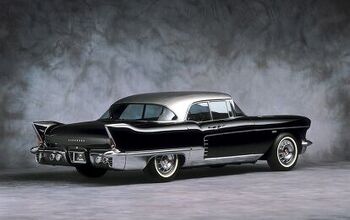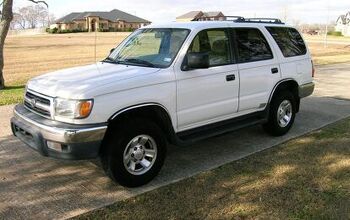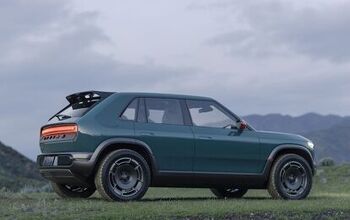Curbside Classic: Five Revolutionary Vehicles – No. 5 – 1945 Willys Jeep MB

Two key evolutionary developments define humans: a large brain and the ability to run long distances cross-country. That explains why the Jeep is the most iconic vehicle on the face of the planet. The fruits of our brain activity increasingly entrapped us in urban confinement and the constraints of pavement. The Jeep offered the way out: the freedom to take us anywhere our legs once had, and our horses after that. It embodied the cowboy myth, updated for the second half of the twentieth century; the last hurrah of Americans’ conquest of its open spaces. The Jeep became the mechanical alter-ego of man. Well, at least of one six-year old.
My father being an inveterate hiker, long family walks that started at our house in the center of Innsbruck and ended up in the Alpine slopes were a regular affair. In the city-center areas, I was a streetcar whose electricity came through a stick that I would brush along the walls of the buildings. The gaps between them meant a dangerous drop of energy (and attendant humming noise), and I would just barely be able to coast to the next one. As we reached the less densely-built areas, I would become a car; choice of make, model and its corresponding noises depended on my mood.
But once we made the abrupt transition from the flat valley to the steep road heading up the hillside, I always became a Jeep. The Go Devil four’s blubbering exhaust kept my lips busy. My hands were occupied finding the right combination of range and gears with that assortment of levers on the floor in order to keep me moving over any terrain, even at a crawl over big rocks. The only problem was that I had a small gas tank, and the Jeep would inevitably run out of fuel and sputter to a stop. To my father’s eternal frustration, that meant the turnaround point in the hike, unless the Jeep conveniently happened to stop in sight of a Gasthaus or Alm Hutte.
I can credit my early influential Jeep exposure to its original purpose: the winning of WW II. The Allies left behind enough of them for the tiny post-war Austrian military to adopt as their own. At least those ended up in the hands of the former enemy legitimately. My father, who was a medic on the Russian front with the Wehrmacht, remembers how highly prized captured Jeeps were. The Germans were in full retreat from the Russians in the Ukraine during the winter of ’43-’44. When a sudden thaw turned the countryside into a morass of knee-deep mud, the German trucks and VW Kubelwagen were at a severe disadvantage for lack of front driving axles.
But the powerful 4×4 Jeeps (60 hp compared to the VW’s 25) and the highly prized 6×6 2.5 ton GMC and Studebaker trucks that the Russians got from the US were seemingly unstoppable in the Ukrainian mud, which was all-too similar to that in the US Midwest. Every German unit tried to end up with at least one Jeep and as many “Studebakers” as possible. Western Europe was a densely built-up land of many roads, leading to military transport solutions that either favored road-limited vehicles, like the RWD trucks and VWs, or the more extreme but maintenance intensive off-road solutions like the German half-tracks. The American adoption of mass-production AWD technology equally at home in both conditions was a revolutionary solution that helped win the war and changed the perceptions of cars’ possibilities forever. And armies around the world quickly copied the Jeep, legitimately or not.
Enough of the enemy’s perspective. There’s not enough time here but to give a quick overview of the Jeep’s remarkable beginnings and war-time accomplishments. Bantam Motors, a tiny struggling maker of teeny cars, responded to an RFP from the military in 1940. Using Spicer axles and transfer cases, they cobbled up the first proto-Jeep in a few weeks. Willys and Ford also developed prototypes. The big hurdle for those two was the military’s extremely low weight target, initially 1200 lbs. Bantam had the tiny engine and small-car experience to do what Ford and Willys couldn’t. Early test were promising and a modest number were built for grueling tests.
Eventually, the weight limit was pushed up to 2160 lbs, giving the Ford and Willys the edge in developing the definitive Jeep. The more powerful 60 hp engine ultimately gave Willys the nod, and Ford ended up building Jeeps under license. Bantam was left out in the cold, building trailers for the vehicle it created. Here’s a wonderful ten minute video of the Jeep’s early days, its grueling tests and subsequent success: the “Autobiography of the Jeep” . If you look carefully, there’s a brief glimpse of an original curved-nose Bantam prototype on the test range at 3:31 minutes.
Some 640k Jeeps were built during the war, for $648 each ($7850 adjusted). This nice example was built in 1945. The owner, a neighbor down the street, drives it regularly, preferably with the windshield down in the summer. It still brings up a tinge of deep seated desire and envy every time I see him bopping down the road with the wind in his face. Once a Jeep, always a Jeep.
I did finally buy one, an ’85 Cherokee, during the early days of the second wave of Jeep-driven SUV mania. But the Cherokee was a long way from the cheap surplus Jeeps that started the 4×4 boomlet after the war. They, and the subsequent post-war CJs did for off-roading what the Model T had done on-road.
Prior to WWII, four-wheel drive was an expensive and relatively rare proposition. Marmon-Harrington and other companies offered 4×4 conversions, mainly to Ford passenger cars. They made great hunting rigs for the affluent, but their high cost made them inaccessible to the average Joe. But the mass production of four wheel drive components for the Jeep changed the equation forever.
The Jeep’s post-war revolution’s first stage was somewhat slow in developing. Surplus Jeeps were cheap. Willys tried to market the civilian CJ-2 as an agricultural tractor alternative. Eventually, off-shoots like the Willys Jeep Wagon and its successor, the Wagoneer, began to expand and civilize the four-wheeler market. By the sixties, the other manufacturers could smell the 4×4 future coming. The IH Scout and Ford Bronco jumped in first. The sea change came with the K5 Blazer in 1969 and its pick-up-based imitators. And 4×4 pickups themselves began to morph from butt-busting hard-sprung beasts to more civilized incarnations. By the seventies the SUV moniker was coined, and the first SUV phase was exploding, although then it was mostly a manly affair.
The second phase is closely associated with the Cherokee and its ilk: more reasonably sized and much more civilized. Now it was Mommy who didn’t want to be seen in anything other than a Cherokee or Explorer at the school parking lot. As gas prices kept dropping, Suburbans and Expeditions took their place. And now we’re in the deep end of the third phase: CUVs. But as they become ever more car-like, the Jeep influence is getting mighty hard to discern. What exactly does an AWD Flex have in common with a Jeep other than four driven wheels?
The truth is, the Jeep’s remarkably long reign as the source of automotive dreams and trends is well over. Looking back on it, it was one of the more ridiculous mega-automotive manias ever, once it metastasized. Why would folks that would never contemplate dropping a wheel off a curb punish themselves with hard-riding, ill-handling, gas-guzzling beasts? I ask rhetorically because I already know the answer.
The freedoms to zip down the road in a Mustang with hair in the wind or escape to a hidden mountain lake in a Jeep are both deep-seated and cherished symbols of the exuberant post-war American experience. But change is blowing in the wind, and the question to ponder is not why we all drove them, but whether these icons have truly run their course, forever? And if so, what revolutionary agent has taken their place?

More by Paul Niedermeyer
Latest Car Reviews
Read moreLatest Product Reviews
Read moreRecent Comments
- EBFlex Will I miss the Malibu? No. Will GM miss the Malibu? Absolutely. They are going from making a vehicle that makes money moving 150k a year and converting the plant to make EVs (that nobody wants) at a loss every year and far less volume. The amount of stupid that is always present when it comes to EVs is astounding. The experiment is over GM. Move on
- Mike Beranek In the sedan game, it's now either Camry or Accord. The rest are just background noise.
- Theflyersfan I know their quality score hovers in the Tata range, but of all of the Land Rovers out there, this is the one I'd buy in a nanosecond, if I was in the market for an $80,000 SUV. The looks grew on me when I saw them in person, and maybe it's like the Bronco where the image it presents is of the "you're on safari banging around the bush" look. Granted, 99% of these will never go on anything tougher than a gravel parking lot, but if you wanted to beat one up, it'll take it. Until the first warning light.
- Theflyersfan $125,000 for a special M4. Convinced this car exists solely for press fleets. Bound to be one of those cars that gets every YouTube reviewer, remaining car magazine writer, and car site frothing about it for 2-3 weeks, and then it fades into nothingness. But hopefully they make that color widespread, except on the 7-series. The 7-series doesn't deserve nice things until it looks better.
- Master Baiter I thought we wanted high oil prices to reduce consumption, to save the planet from climate change. Make up your minds, Democrats.







































Comments
Join the conversation
Herr Niedermeyer, may I take this opportunity to correct you on one point: the originators of the Jeep were called the American Bantam Car Company, and not Bantam Motors! As an aside, the designer went by the most Germanic name of Karl Probst.
I response to OrkneyDullard's comment, I seem to remember hearing that Land Rover used aluminum body shells/panels which didn't rust. Unfortunately, they didn't know how/didn't bother to make the steel frames resistant to rust. Also, I think there were rust issues where the aluminum and steel touched, such as around the edeges of the doors. Thus, the body outlasted the frame. I do not seem to rmember similar complaints from Jeep owners.